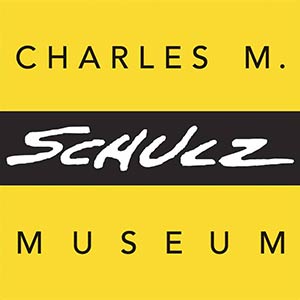Remembering Sparky’s France
It is always a wonderful surprise when an exhibition is installed and becomes open to the public. It transforms a collection of pieces into a story. In one of the current exhibitions, A Change of Scene: Schulz Sketches From Abroad, is a wonderful story that accompanies the sketches from France, which you see here.
Shortly after we were married, Sparky and I went back to visit his “army buddy,” Elmer Hagemeyer, and to attend a Company B reunion. Sparky was intrigued to discover that several of the attendees had gone back to trace the route their squad had followed in 1945. The squad’s unofficial historian, Art Lynch, had complete maps and material from “then and now.” Sparky very much wanted to make a similar trip, and so we did. Using Art’s maps and with a very helpful driver, we made the journey with Helen and Bill Melendez. Bill became a family friend through his role as Director and Animator on the Peanuts animated specials. Together we found Château Malvoisin, where Sparky’s squad, along with some other squads had been billeted for six weeks around February of 1945. The drawings you see here were about a mile up the road from the château. The “village” consisted of a church, a school, and a bar/ restaurant. To Sparky it looked as if time had stood still. He spoke to the bartender, telling him with gestures and broken French, “I was here during the war.” The host replied in French, “I was here, too.” “I played this game here,” Sparky pointed to the foosball game. “No,” the host said, “it was over here,” pointing to a corner. Amazing!
As for the Château, it was boarded up, and we squeezed through a small opening into the courtyard. The grass was waist high (my waist, anyway). But it didn’t matter to Sparky because his squad was assigned to a lean-to area up against the inner wall. He showed us exactly where he had laid his sleeping bag, and he pointed out where the other soldiers slept. It looked as though the war had ended and this entire area had been suspended in time, waiting 35 years for him to return to the place he had been as a young soldier, knowing now that he survived it.
Even more amazing to the story is that when we returned a year later with the film crew of Karen and David Crommie to document the story for What Have We Learned, Charlie Brown, the entire place had changed. The Château had been rented out or sold, and it was all spiffed up. And the little café had been transformed into two small apartments. The scene we had been talking about for a year was gone. Imagine our surprise. But to me, there was something perfect about it. It was as if the scene remained suspended in time so that Sparky could revisit it. Once that had happened, history could continue. I am so grateful for things suspended in time. I wish more things could be, but I know they cannot.


Here are two sketches from our time spent in France.
During our second visit to France, in September of 1978, we also filmed for the documentary To Remember. While filming, we were fortunate enough to spend a few days in the Paris apartment of Connie Boucher, who was a licensee of the Peanuts characters and owner of Determined Productions, Inc. We saw Notre Dame up close, inside and out, but Sparky chose this view from the apartment, which was on the left bank on Rue Maître Albert, for his drawing.


The little triangle with the children playing soccer was a view straight down from our 3rd floor window. Three narrow streets converged there and the scene below was like a Fellini film: cars coming down the narrow street, children scattering then quickly rejoining their game. There was the occasional “plink” as the passing car nicked the mirror of one of the parked cars. Sparky laughed at the idea that the drivers just drove on, as though this happened all the time; and in fact it did.
On our trips to Europe we made it a habit to visit my Aunt Betty to “rest up” from the journey. Sparky and Betty were very fond of each other, and he loved to tease her. Some drawings of her home are in the show, and I will tell about them in a future posting.
—Jean Schulz


